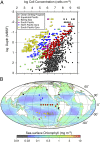Global distribution of microbial abundance and biomass in subseafloor sediment
- PMID: 22927371
- PMCID: PMC3479597
- DOI: 10.1073/pnas.1203849109
Global distribution of microbial abundance and biomass in subseafloor sediment
Abstract
The global geographic distribution of subseafloor sedimentary microbes and the cause(s) of that distribution are largely unexplored. Here, we show that total microbial cell abundance in subseafloor sediment varies between sites by ca. five orders of magnitude. This variation is strongly correlated with mean sedimentation rate and distance from land. Based on these correlations, we estimate global subseafloor sedimentary microbial abundance to be 2.9⋅10(29) cells [corresponding to 4.1 petagram (Pg) C and ∼0.6% of Earth's total living biomass]. This estimate of subseafloor sedimentary microbial abundance is roughly equal to previous estimates of total microbial abundance in seawater and total microbial abundance in soil. It is much lower than previous estimates of subseafloor sedimentary microbial abundance. In consequence, we estimate Earth's total number of microbes and total living biomass to be, respectively, 50-78% and 10-45% lower than previous estimates.
Conflict of interest statement
The authors declare no conflict of interest.
Figures



Comment in
-
Shrinking majority of the deep biosphere.Proc Natl Acad Sci U S A. 2012 Oct 2;109(40):15976-7. doi: 10.1073/pnas.1213639109. Epub 2012 Sep 10. Proc Natl Acad Sci U S A. 2012. PMID: 23012471 Free PMC article. No abstract available.
References
-
- D’Hondt SL, et al. Distributions of microbial activities in deep subseafloor sediments. Science. 2004;306:2216–2221. - PubMed
-
- Jørgensen BB. Mineralization of organic matter in the sea bed—The role of sulphate reduction. Nature. 1982;296:643–645.
-
- Schippers A, et al. Prokaryotic cells of the deep sub-seafloor biosphere identified as living bacteria. Nature. 2005;433:861–864. - PubMed
Publication types
MeSH terms
LinkOut - more resources
Full Text Sources

